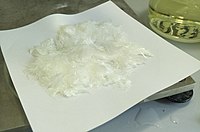
Photo from wikipedia
Herein, a novel luminescent Zn-LMOF, JLU-MOF109 ([Zn(PBBA)(H2O)]·3DMF·2H2O, PBBA = 4,4'-(2,6-pyrazinediyl)bis[benzoic acid], DMF = N,N-dimethylformamide), was successfully synthesized under solvothermal conditions. Zinc ions are connected by PBBA ligands to form two-dimensional… Click to show full abstract
Herein, a novel luminescent Zn-LMOF, JLU-MOF109 ([Zn(PBBA)(H2O)]·3DMF·2H2O, PBBA = 4,4'-(2,6-pyrazinediyl)bis[benzoic acid], DMF = N,N-dimethylformamide), was successfully synthesized under solvothermal conditions. Zinc ions are connected by PBBA ligands to form two-dimensional (2D) layers, and the layers are further propped up through hydrogen-bonding interactions. JLU-MOF109 exhibits good sensitivity to inorganic pollutants, Fe3+ and Cr2O72-, as well as nitro aromatic explosives, 2,4,6-trinitrophenol and 2,4-dinitrophenol. JLU-MOF109 exhibits high Ksv (at 104 M-1 level) and low limit of detection values (∼10-6 mol/L) for the abovementioned hazardous pollutants, which is better than a majority of previously reported MOF-based fluorescent sensors. With good stability in the aqueous phase, JLU-MOF109 can serve as a promising chemical sensor for pollutant detection in wastewater.
Journal Title: Inorganic chemistry
Year Published: 2023
Link to full text (if available)
Share on Social Media: Sign Up to like & get
recommendations!